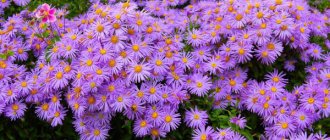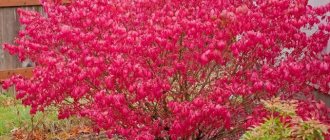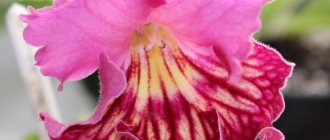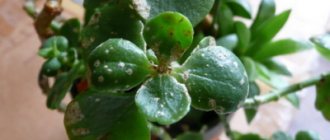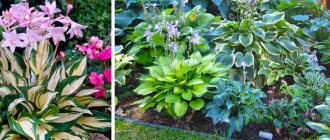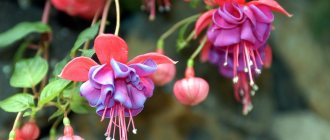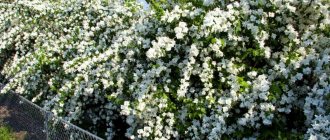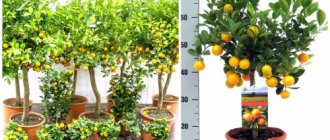Croscomia or Japanese gladiolus (Montbrecia) is a perennial from the bulbous family. The translation of the name from Greek means the smell of crocus. This strikingly beautiful flower has tall (1-1.5 m) intensively arranged stems with great branching. Its smell can be confused with saffron. The appearance of the stem with buds is similar to gladiolus, which is related to it, as are irises and crocuses.
Small flowers (4 cm), shaped like a funnel, can be observed for quite a long time: from mid-summer to mid-autumn. All gardeners strive to have some unusual plant, but Montbretia does not serve this purpose very often. There are not very many requirements for care and maintenance. When growing crocosmia in open ground, it is necessary to follow certain agricultural techniques that will allow you to have this beautiful flower on your home plot. With its help you can create beautiful unique design compositions.
Description and features of crocosmia
A flowering plant native to South Africa is crocosmia. There are many varieties, but the most popular variety is Lucifer, which is distinguished by its bright red color and tall peduncle. Among gardening enthusiasts, there are different names for the crop, but the most commonly used are montbretia, tritonia and Japanese gladiolus. Dried flowers emit a light and pleasant saffron aroma.
A tropical perennial plant of the Iris family reproduces by bulbs. The graceful long leaves are sword-shaped and grow up to 60 cm in length. The structure is corrugated with longitudinal stripes. Arrangement in spreading bunches. A thin tall peduncle grows up to 1 meter. At the top of the shoot there is an inflorescence of spikes, numbering up to 40 buds, which open gradually from bottom to top.
The variety of varieties shows variations in petal colors from light yellow to brick red. Each flower, when opened, reaches 5 cm in diameter.
Crocosmia is often confused with freesia due to the similarity of the stems or with lily due to the shape of the flower.
The first buds begin to open by mid-summer and continue to delight the gardener until frost. The fruit is a round box filled with rather large seeds of a rich brown color.
Reproduction
The easiest way to get new flowers is to separate the “babies” from the mother bulb . However, you can grow crocosmia from seeds.
Germination of seeds
This process is quite labor-intensive and not very popular among flower growers.
Sowing seedlings
Crocosmia seeds are planted in containers for growing seedlings.
Attention! If you decide to grow Japanese gladiolus from seeds, do not sow directly into the ground: there is a high risk that not a single seed will sprout.
How to sow seeds
The optimal planting time is the end of February . Before planting, the seed is soaked in warm water for about a day.
You can take any container, but a drainage layer must be placed on its bottom. The soil chosen is loose, nutritious, with high air permeability.
The crops are not planted deeply; a hole depth of 0.5 cm is sufficient.
When the seeds are planted, the soil is moistened and the container is covered with cling film or glass. You can place the container along with the rest of the seedlings in a well-lit place.
Seedling care
The crops are opened daily for ventilation and watered with warm, settled water from a spray bottle as needed.
Seedling care
From the moment the first shoots appear, the film is removed from the seedlings. Care remains the same.
For successful development, plantings need:
- stable temperature;
- normal lighting (like any seedlings);
- regular watering.
Crocosmia pick
Plants planted in a common container, after the appearance of 2-3 true leaves, must be dived into separate pots . So the crocosmia will develop until planting in the flowerbed.
25–30 days before planting in the garden, plants should be briefly placed on the terrace or loggia to harden off.
Hardening begins with a few minutes , daily increasing the time spent in a cool space.
Types of crocosmia
In nature, Montbretia is represented by more than 55 varieties; only a small part is cultivated. Let's look at the most common of them.
Massonorum
It is highly resistant to cold and is optimal for growing in northern regions. A low-growing bush 0.6-0.8 cm high with sword-like leaves with a ribbed structure. The stem of the peduncle grows upward and, at the point where the inflorescence begins, turns horizontally, that is, parallel to the ground.
Golden
The species is the ancestor; it was brought from the South African tropics. Flowering time is September. Flowers, depending on the variety, can be colored in orange, yellow and red shades.
Potsa
It grows in the marshy soils of the African continent. In the garden, choose shaded areas with poorly drying soil. The leaves of the plant are thin and smooth, the flowers are small.
Paniculata
The bush, one and a half meters high at the base, is decorated with a bunch of corrugated leaves of a light green hue. Compact inflorescences of bright orange color appear in the second half of June. This species is the earliest of all members of the family.
Ordinary
One of the first garden hybrids created at the end of the 19th century. The height of the plant reaches a meter. The greenery of a light shade consists of erect plates, narrow and graceful. The inflorescence includes small funnel-shaped buds. The first brushes appear in mid-summer.
Description of the plant
The second name for Montbretia is “Japanese gladiolus”, since the plant has some of the characteristics of this bulbous crop. Montbrecia has very decorative inflorescences that resemble lilies in appearance. However, unlike the lily, in this case the flower is small and is collected in group inflorescences.
The height of this crop can reach 1.5 meters, but only in its native habitat - a tropical climate. The middle strip is capable of stretching the plant to a height of 50-100 cm.
The rules for growing are similar to gladiolus, so even novice gardeners can cope with this task.
Montbrecia has in appearance the characteristics of iris, freesia, snowdrop, saffron, and crocus plants, since all these crops are related plants to it. The ideal option for decorating the landscape is to combine Monbretia with echinacea, cannaia, salvia and lilies. The cut flowers of this crop can please the eyes for a long time. Salvia seeds can be grown using seedlings and non-seedling methods.
Montbretia is often called Crocosmia.
Below are the most popular varieties that gardeners and landscape designers often focus on
golden. The variety can reach a height of up to 1 meter and has magnificent thick and decorative leaves. The inflorescences are golden yellow in color and reach a diameter of 5 cm. The variety is recommended to be grown in a shady place, since in nature this montbretia grows in the tropics. The flowering period begins in autumn, and the opened flowers are used to compose a bouquet;
- Massonorum. The variety reaches a height of 0.8 m, has large bulbs and leaves of a specific shape. Flowering continues for a fairly long period, the inflorescences are small in diameter;
- Post. The most resilient type of Montbrecia, the variety is able to survive even under the most unfavorable conditions. Posta is distinguished by long narrow leaves and small decorative inflorescences;
- Lucifer. Lucifer is the most popular type of Montbretia. Lucifer is a hybrid variety. Thanks to this, you can enjoy the riot of colors that this type of culture can give. It is most in demand in the preparation of landscape designs and garden compositions.
Panic. The variety begins flowering at the very beginning of the summer period and ends when the first frost occurs. The leaves have a corrugated structure, and the variety is able to withstand light frosts;
Quite often, montbretia are combined into compositions. To do this, they can be combined both with other flowers and with different varieties of the same plant.
Popular varieties and use in garden design
Crocosmia is popular among hobbyists and landscape designers. Airy inflorescences of bright colors decorate the flowerbeds of almost every plot, so the work of breeders does not stop. To date, more than 4 hundred varieties have been bred.
Let's look at the best of them:
| Variety | Height, cm | Description | Application |
| Emily Mackenzie | 60 | Low growing bush. The flowers are brick orange with a bright spot in the center. | Used in group compositions in mixed flower beds. Combines with crops that bloom in late summer. |
| Lucifer | 150 | Frost-resistant variety. Large blood-red flowers are deservedly recognized as one of the most beautiful. | Cut, used in bouquets and in exterior design as background plants. |
| George Davidson | 70 | Juicy flowers of an amber-yellow hue look good against the backdrop of dark greenery. | Ideal for tabletop compositions. |
| Red King | 90 | The buds are red-orange with a bright center. | Grow as a houseplant. |
| Spitfire | 60 | Orange inflorescence on a delicate stem. | In gardens and on window sills. |
| Tangerine Queen | 120 | They are grown in flower beds. |
Given the long flowering and bright color of the buds, the crop is widely used for the design of exterior compositions. As a rule, the bush is planted in the background, where the lower green part serves as the background, and the inflorescences on graceful legs add air and completeness to the design.
Diseases and dangerous pests
This plant is distinguished by its immunity to almost all diseases, however, lack of appropriate care and excessive moisture can provoke the following diseases:
- Gray rot. Rot bacteria multiply at a rapid pace in conditions of high dampness and cover the crowns with a gray coating that has an unpleasant odor. To prevent it, it is recommended to maintain an irrigation regime.
- Fusarium. A fungal disease, which is characterized by leaves turning yellow and falling off, destruction of the peduncle and a further change in the color of the flowers. Fungicides are used for treatment.
- Herbaceousness. An incurable flower disease of viral origin, which is spread by leafhoppers. Characteristic features of an infected plant are yellowing and drying of the foliage.
To prevent various pathologies, before planting, seeds and bulbs should be treated with potassium permanganate, diluted to 1%. Among the parasites that often infect this plant are:
- Thrips are parasites that feed on plant sap. Their presence is indicated by small pale spots or stripes. The foliage gradually dries out, the stems become distorted, and the flowers wither and fall off. Karbofos, Confidor and other fungicides are effective against them.
- Mole crickets are insect pests that eat the corms of plantings. To catch these parasites in the autumn, dig a hole about 50 cm deep and place manure in it. This will be a bait for them. In the last weeks of autumn, when the insects have already settled in for the winter, the pit is opened and they are all destroyed at once.
- Spider mites are a parasitic pest that affects the part of the plant located above the soil. Mites suck the juices from the plantings, which first leads to the falling of leaves, and then to the drying out and death of the entire plant. Absolutely any insecticides are suitable for solving problems with this parasite.
Designers and gardeners get great pleasure from working with Montbrecia. Its slender green thickets with bright drooping inflorescences are a wonderful decoration for the garden, and the cut flower stalks last a long time in the vase, blooming new buds.
Mr. Summer Resident recommends: combining crocosmia with other plants
Tall perennial crops are optimal as neighbors. Among them, we can especially highlight rudbeckia, popovnik, catnip, speedwell, and Rogers.
A combined composition of perennial shrubs is assembled taking into account the flowering time and in such a way as to please the eye with the splendor and brightness of colors. Modern hybrid varieties demonstrate diversity that allows you to create flower beds only from crocosmia.
Flowers are indispensable for landscape decoration. It has shown itself well in wall cascades decorating cracks and dilapidated parts of buildings. Shrubs are widely used in decorating artificial reservoirs.
Possible difficulties
Crocosmia can suffer from fungal diseases when grown in flooded soils. Replanting and treating with a fungicide will help save you from rot. Flowers may also suffer from fusarium. The bulbs become dark, soft and streaky. It is very difficult to cure them; it is better to isolate and destroy the affected plants.
With jaundice (grassiness), the bulbs turn yellow and become very dense. They produce many shoots with thin yellow leaves. At the early stage of the disease, heating the bulb to a temperature of +45°C helps to completely recover.
Among the pests that destroy crocosmia are mole crickets and thrips. Treating the soil and planting material saves you from them.
Growing methods
Like all plants of this family, croscomia can be cultivated using two ways: from seeds or from bulbs. The first method of reproduction is quite lengthy, because... The time from planting to the appearance of the first flowers takes about 3 years. The second way is shorter by about a year, because you don’t have to wait for the bulb to form.
Growing crocosmia by seeds
This method is not complicated and is accessible to almost everyone. The main condition is compliance with a certain order:
- Prepare suitable dishes: small plastic cups or special containers. They must have drain holes.
- Take the necessary soil (buy or create it yourself). Composition: turf, humus, peat and coarse sand. Proportion 2:1:1:1.
- Fill the container: the first layer is expanded clay, the rest is ready-made soil.
- Stimulate seed growth by placing them in a special solution. Dry and press not deep into the soil.
- Wet the surface and cover with film. Place it where it is warm and light.
- Ventilate constantly and moisturize as it dries.
- Remove the covering material when shoots appear.
- Place in a separate bowl if there are 3 leaves.
- Harden off before planting in the garden, periodically taking it out into the air.
Growing crocosmia bulbs
The bulbs are planted in mid-spring after the likelihood of frost has disappeared directly into the ground. Soil temperature +10 °C. You must follow this order:
- Separate the bulbs from the children and place them in a warm place for a while.
- Dip into manganese solution before planting. The depth of penetration into the soil is 4-5 cm.
- Leave 12 cm between the bulbs.
You can change this procedure slightly. At the beginning of spring, plant the bulbs in pots and place them near the window. Planted in the garden after sprouts appear. In this case, flowering will begin faster.
Planting seedlings and crocosmia bulbs in open ground
Transplantation directly into the garden is carried out in mid-spring. It is advisable to prepare the place in advance, in the fall. Add 2 buckets of humus, 100 g of hydrated lime, 40 g of superphosphate, 20 g of potassium chloride per m2. In spring, be sure to apply 30 g of nitrogen fertilizer per m2. The planting pattern is 10x10 cm and the same depth. The distance can be reduced if you take very small bulbs. Each hole with a plant is filled up, watered and covered to get used to the new conditions.
Caring for crocosmia in the garden
Growing conditions
Caring for crocosmia is no more difficult than caring for gladioli. Water the plant generously once a week. After watering, it is advisable to loosen the soil in the flowerbed so that a crust does not form.
Planting and caring for Montbrecia requires regular feeding of the plant. You can grow crocosmia without fertilizing if you planted it in fertile soil, but if the soil in the area is poor, starting from the appearance of the second leaf, fertilize the soil every 10 days with mullein infusion (one part of the fertilizer is infused in 10 parts of water) and full mineral fertilizer, dissolving 2 g of the drug in 1 liter of water.
During the formation of crocosmia buds, potassium fertilizers are more needed. As you can see, caring for a crocosmia flower is not at all difficult, and if planting montbretia and caring for it in open ground are carried out in accordance with the agricultural practices of the crop, you should not have problems with flowering and plant health.
Reproduction of crocosmia
As already mentioned, crocosmia reproduces by seed and vegetative methods. You already have an idea about the seed propagation of Montbretia, and vegetative propagation is carried out by dividing the corms. Every year, about five children are formed around one adult corm, which bloom the next year. The mother plant continues to produce children.
Growing and caring for crocosmia involves regular division and planting of the plant's corms. From time to time, when the crocosmia planting becomes too dense, the corms are dug up in the spring, the children are separated from the mother bulbs and planted. Crocosmia should be planted at the same time as its seedlings are planted in the flowerbed - at the end of April or beginning of May. Before planting in open ground, you can plant crocosmia in pots to grow the bulbs a little, and in May or June transplant them into a flowerbed along with a lump of earth.
Pests and diseases
Crocosmia is a plant resistant to both diseases and pests, however, as a result of insufficient care or prolonged waterlogging of the soil, it can be affected by the following diseases:
- Pyracantha: growing and caring for the garden
Fusarium, which first of all causes the leaves of the plant to turn yellow, dry out and die, the flower stalks become bent, the flowers are deformed, and their color changes;
Gray rot, covering crocosmia bulbs with a fluffy gray coating;
Jaundice, or herbaceousness, from which the tips of the leaves first turn yellow, and then the foliage acquires a straw hue, and the plant dies. This viral disease is transmitted by leafhoppers.
To combat fusarium, fungicides are used to treat montbretia; gray rot is easier to prevent than to get rid of, and jaundice cannot be cured even with a strong desire - no cure has yet been invented for viral diseases. To prevent all kinds of diseases, planting and caring for montbretia must be carried out in strict accordance with its agricultural technology; in addition, it is necessary to treat the seeds before sowing and corms before planting with a one percent solution of potassium permanganate, and from time to time change the area for crocosmia.
Among the pests that pose a danger to Montbrecia are mole crickets, thrips and especially spider mites.
Mole crickets feed on the corms of the plant and lay their offspring in the soil at a depth of 10 cm, and they can only be removed by setting insect traps: in early autumn, fresh horse manure is placed in a hole about 50 cm deep, after which the hole is covered with earth and the place is marked with a stake. After a while, the hole is dug up and the mole crickets that have settled in the manure for the winter are destroyed.
Thrips feed on plant sap, causing discolored spots, stripes or streaks to appear on the leaves. Leaves die, stems become bent, flowers lose their beauty. To combat thrips, use the drugs Agravertin, Fitoverm, Actellik, Karbofos or Confidor in accordance with the manufacturer’s instructions.
Spider mites may appear on crocosmia during dry periods. These are sucking insects that pierce the ground parts of the plant and feed on its sap. In addition, ticks are carriers of incurable viral diseases. In the fight against spider mites, the same insectoacaricides are used as for the destruction of thrips.
Preparing for winter
If the winters are cold in the area where crocosmia is grown, then it is advisable to dig up the bulb for this period. This is usually done at the end of October so that it is fully ripe. After this, dry in a room at +10 ° C and with good air access. They are stored in winter in the same way as gladioli bulbs, at a temperature of +3...+7 °C and a humidity of 70%, ensuring sufficient air exchange, in the basement, laid out in boxes and covered with moss or sand.
If the winters are mild, then you don’t have to dig up the bulbs, but you need to cover them with a layer of mulch and add shavings or dry leaves on top.
If the areas are warm, then it is enough to collect dry leaves and cover the area with flowers with them. Cover the top with film. It is removed after frost and last year's leaf blades are cut to the ground.
Planting and care
The crocosmia flower is not at all a capricious plant, but it is still worth listening to its wishes so that it shows itself in all its glory.
Caring for the plant involves choosing a well-lit area, as the plant has southern roots. If there is not enough sun, buds may not form and the plant will not bloom. It will be good if there are no drafts at the planting site.
Crocosmia is particularly undemanding when it comes to soil, but still prefers it to be moisture-permeable. And yet, close groundwater will negatively affect the vitality of the plant, since Montbrecia does not tolerate stagnation of liquid in the roots. It is important to water crocosmia regularly, although it is drought-resistant, to free it from weeds, and also not to forget to remove faded inflorescences so as not to deteriorate the appearance of the plant.
It is better to prepare the area for montbrecia in the fall by mixing the soil with organic and mineral fertilizers. Thanks to fertilizing, the number of buds increases, and the plant as a whole looks more well-groomed and healthy.
Bulbs are planted at the end of April or in May, when the weather is warm.
In regions with a mild climate, the bulbs can be left in the ground to overwinter. But first you should sprinkle the crocosmia with fallen autumn leaves to make it warmer. Having coped with the first winter, the plant will become more hardened, and subsequent frosts will no longer be so terrible for it.
